Adventure
Priya Phadtare
During a recent trip to Rajasthan, India, I decided to bring my camera along and take pictures of this
majestic land of colours and kings filled with wonders. My original itinerary included overnight stays atJaiselmerand Jodhpur but I decided to include
Khichan in the plan as well considering it was just 150 kilometers from Jodhpur on the way to Jaiselmer.
Khichanisa sleepy and a dusty
hamlet of thePhalodi Tehsil which is inhabited by the community of Marwaris.
The village is like any average dessert village found in Rajasthan except that it is the migratory pit-stop of the smallest and the second most abundant species of the crane species, the Demoiselle crane, around the world from the months of August to March.
One gets to see a maximum number of these birds in the months of December and January. I consider myself lucky to have chosen December to travel to Rajasthan.
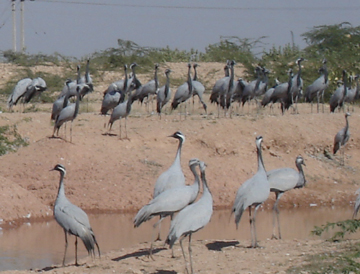
The beautiful Demoiselle cranes gather around a cluster of at least five ponds inKhichanwhich are maintained by the locals.
A chat with Ratanji, a local Marwari helped me know the behavioral patterns of the birds better since he had been feeding them grain for the last many years. The cranes keep on hopping around the village the entire day as part of their daily routine.
In the morning they are fed grains in rectangular enclosures known as the chugga gharsafter which they descend into the areas around the ponds for a drink and a bath, a little away from the feeding area, in the afternoon. This is when I managed to
spot them. Ratanji told me that they are primarily omnivores but in Rajasthan they have become habitual of eating grain, otherwise they sometimes also feed on small animals and insects.
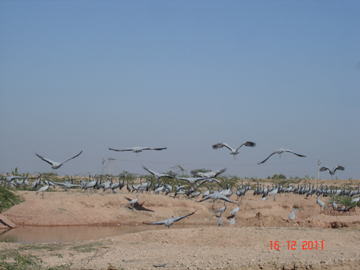
The cranes start their journey from Mongolia and the adjoining regions, which are their primary breeding grounds. The locals have
managed to decipher their flying pattern and community dynamics after observing them for quite long. I was told by Ratanji that they are very punctual and indulge in peculiar flight patterns. The birds are always led by a female crane followed by the offspring
perhaps and always mostly flanked by the males of the group. The cranes are known to exhibit strange communication characteristics like jumping, tossing grass and twigs around and sometimes also flapping their wings to attract the other’s attention. The noises
they make are very similar to the noises a duck makes. Perhaps we could call it a cross between the sounds produced by a duck and a goose.

The birds are extremely alert, I found out about this when I was slowly inching towards a group to get good photographs which is when
I happened to accidentally step upon a branch which made a noise and alerted them. I am kind of glad I did so as what I saw next was truly breathtaking. At least a congregation of 1500 birds systematically turned and took off in batches of five or six towards
a nearby pool. The pond I was standing next to became deserted in a matter of ten minutes! I decided to just lay down on my back on the bank of the pool and look at the birds flying over my head with a potential danger of me being bombarded by unpleasant bird
by-products, which fortunately decided to give me a miss. I noticed how the cranes have the most beautiful flight of all the birds I have seen until now as I saw that they flew with their spindly legs stretched backwards which were perfectly aligned with their
bodies. It was wonderful to see these birds with white-grey plumage soar into the blue skies with sun reflecting off them.

The one and a half hours I spent around the ponds in the company of these constantly chirping birds with the majestic sand dunes and
little mud huts making for a spectacular backdrop were the most peaceful and almost therapeutic one and a half hours of the trip. I look forward to see how the golden of the sand, the blue of the water and the sky and the grey of the birds get together to
create magic again next year same time.
(Text and photographs by Priya Phadtare, student of biochemistry at Sri Venkateswara College, New Delhi)
|
Amazing Facts About Wildlife
Australia, bushfires and megafauna
Introducing elephants has been suggested as a solution to the crisis down under, says S.Ananthanaryanan.
Bush fires in Australia are like the seasons. Vast tracts are destroyed by fire every year, starting in the North in the winter and moving to the South in the summer. Every few years the raging comes to peak and the fires of 7th Feb 2009, now known as Black
Saturday, were the deadliest on record – 400,000 hectares destroyed, 173 people dead.
David Bowman, professor of environmental change biology at the School for Plant Science, University of Tasmania, Australia, in a Comment in Nature, has reviewed the suggestion of introducing mammoth species to restore ecological balance and control fires.

Extinction of mammoths
Large, plant eating animals that ranged the earth went extinct around 50,000 to 12,000 years ago, when humans appeared on the scene. While climate changes also played a role, it was perhaps the humans, who could target the mammoths with spears, arrows and slings,
who pushed the mammoths out of their feeding grounds and into extinction. Smaller animals, which presented difficult targets and reproduced faster were able to survive.
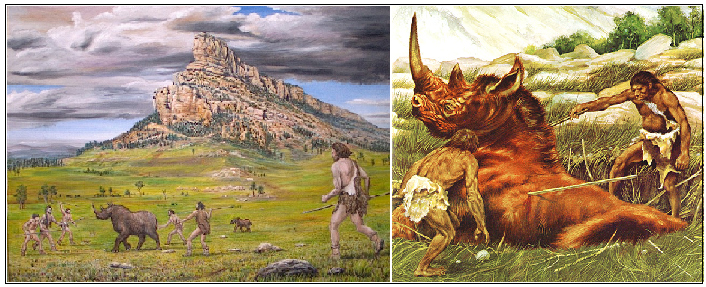
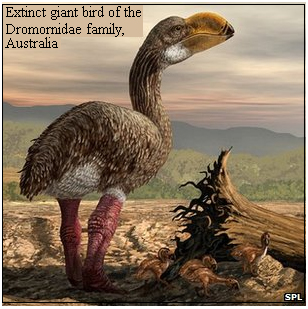
The extinction of large animals affected the flora, with larger bushes and grasses being left to grow wild. In Australia, the extinction of animals was of giant, Kangaroo-like animals, giant lizards and large, flightless birds. The food chain – of large plants
being eaten and large dung and carcasses to recycle nutrients - broke down and the landscape changed. The disappearance of the mammoths created breaks in the continuity of the food web, or niches in the ecosystem, and these were left unoccupied. The animal
species which disappeared were replaced by smaller species, pigs, goats, cattle, horses, donkeys, camels, buffalo and deer, and their predators, which include the Dingo or Australian wild dog, and the new entrants have been rebuilding the ecosystem. But the
larger bushes have been left to grow unchecked, for animals evolve but vegetation takes longer to adapt and the Australian ecology has stayed out of balance.
Paul S Martin, who was a geoscientist at the University of Arizona, said that ecological communities in North America did not function in the absence of megafauna, because much of the native flora and fauna cannot turn around the path of evolution which progressed
in the presence large mammals. Things were aggravated in Australia by foreign grasses and animals species, which came with Europeans and threaten native strains and compete for resources. The early human communities had followed practices of burning patches
of bushland for cultivation. But with the loss of aboriginal peoples and traditions, this practice has stopped and the growth of wild flora is unchecked. The aboriginal practice of hunting also kept down the population of smaller, wild animals. But this is
no longer the case and the animals cause more environment degradation.
The Australian Government goes to great expense to deal with the problems. The methods include chemicals to control of wild grasses and barriers to the spread of fires, which are expensive and only partly effective. To check animal menace, there has been poisoning
of the Dingo populations and even crude measures like tracking wild buffalo by radio collars and helicopter, to shoot members of herds. The killing of Dingo disrupts their social structure and eliminates an effective way to control smaller animals, like foxes,
which were introduced by European settlers, and the pig and rabbit population, which attack vegetation and cause erosion and habitat destruction. Ironically it is wildlife and vegetation that are the risk factor for the environment in Australia.
Restoring balance
Professor David Bowman says this approach of taming an eco-structure gone wrong may never arrive at a solution. He has proposed measures that would go the root of the problem, which is to stabilize the food web. The two problems, of animals running amuck and
the flammable grasses growing wild, he says, need to be tackled by predators to control the animal population and by large herbivores to check the grasslands. Stopping poisoning of the Dingo would by itself make for predation of the smaller animals. For larger
species, like the buffalo, Prof Bowman suggests making use of the community of aboriginal hunters in Australia. “Ranger programmes that enable indigenous people to return to their roots — by hunting buffalo or managing natural resources — have been shown to
have social and health benefits for this disadvantaged sector of the Australian community”, says, Prof Bowman.
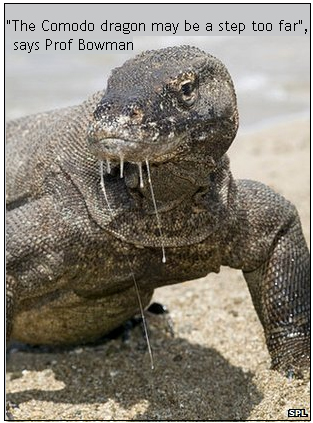
As for the menace of bushland fires, he notes that a major cause is the growth of Gamba grass, a giant African grass that has invaded Australian plains. The grass “is too big for marsupial grazers (kangaroos) and for cattle and buffalo, but it is a great meal
for elephants and rhinoceroses,” Prof Bowman writes. “The idea of introducing elephants may seem absurd, but the only other methods likely to control Gamba grass involve using chemicals or physically clearing the land, which would destroy the habitat. Using
mega-herbivores may ultimately be more practical and cost-effective, and it would help to conserve animals that are threatened by poaching in their native environments.”
The idea is not far different from the ‘rewilding’ inititatives in North America. It has been noted that most living megafauna are threatened or endangered. But they continue to influence the communities they occupy, as the communities evolved in the presence
of the same large animals. Re-introducing into the environment the mammoths that lived in prehistoric times, or their surviving cousins, could invigorate the ‘evolutionary potential’ of these species and also fill the ‘ecological niches’ that have been vacant,.
The idea in North America is a ‘Pleistocene rewilding’ or recreation of the environment of over 10,000 year ago, with camels and lions, and it has its share of critics who argue that the earth is now not the same as it was during the Pleistocene.
Nor is Prof Bowman without critics in Australia.” Elephants could become the ‘10-tonne cane toads’ of the Australian outback if they were introduced to control invasive grasses,” says Patrick O’Leary of the Pew Environment Group, an active think tank and action
agency. But Prof Bowman is not blind to the challenges his idea would pose – and he cites resources, “we could adopt management methods from game parks and reserves, such as building fences, regulating the availability of water and food, and con¬trolling breeding
and hunting”, he says. Using animals to deal with problems that otherwise call for huge investments and energy use could be effective and green at the same time.
[the writer can be contacted at simplescience@gmail.com]
|
Calendar of the month
RagooRao from Mysore has done some beautiful digital paintings, which we have converted
into monthly calendars. Please download these calendars free and use them as your desk top wall paper.
By clicking on RagooRao's name, you can read the numerous articles he has written for IndianWildlifeClub.com. He is also a superb nature photographer.
To download the calendar suitable for the size of your desktop, please
click here
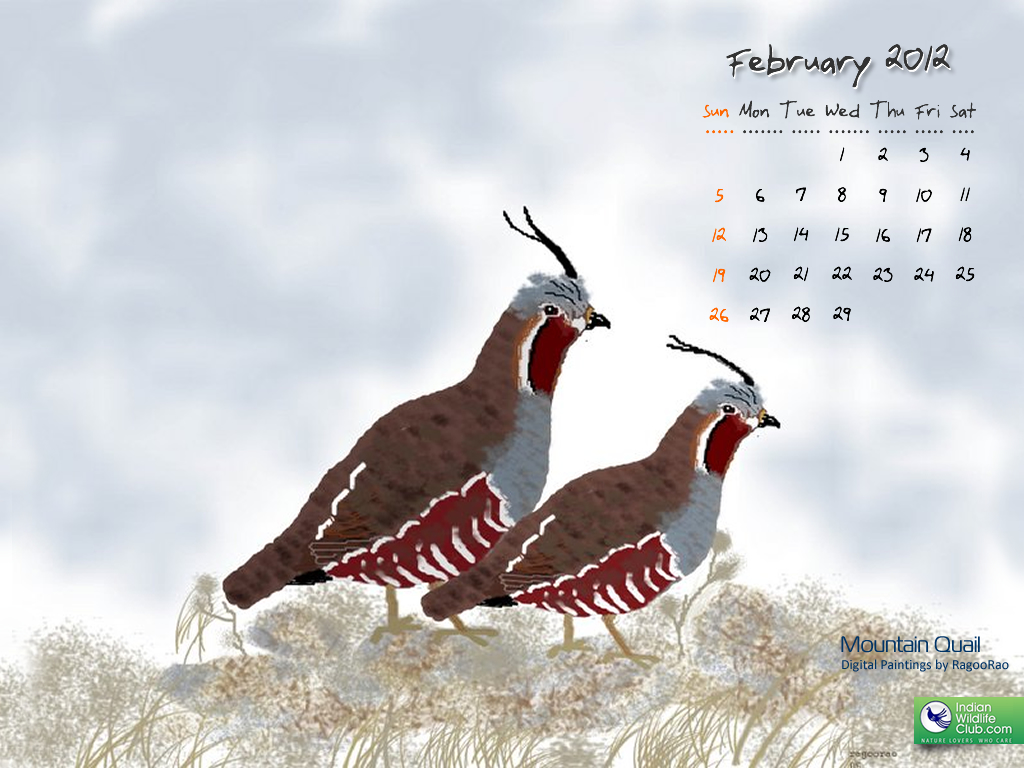
|
Calendar of the month
RagooRao from Mysore has done some beautiful digital paintings, which we have converted
into monthly calendars. Please download these calendars free and use them as your desk top wall paper.
By clicking on RagooRao's name, you can read the numerous articles he has written for IndianWildlifeClub.com. He is also a superb nature photographer.
To download the calendar suitable for the size of your desktop, please
click here
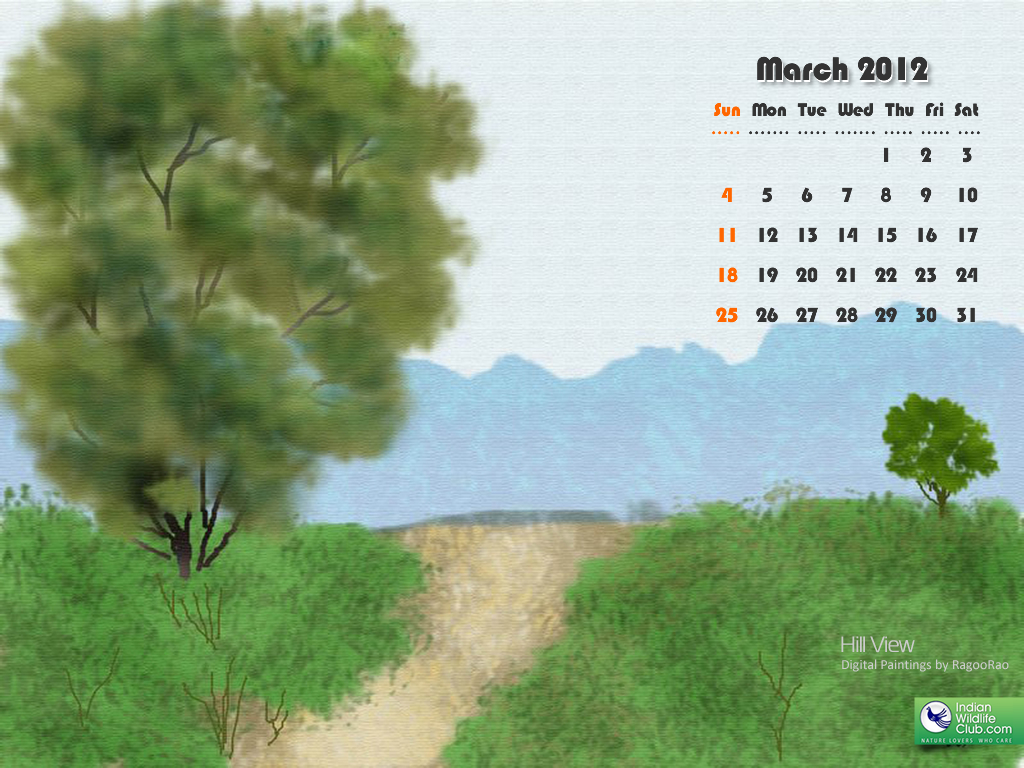
|
Did You Know ?
Did you know?
Adaptations of wildlife in rainforests
-
Rainforest adapted animals like the LTM and gibbons will often be the first to go when the forest goes.
-
Many in rainforests have buttress roots (to be stable in what are often shallow soils, trees with shallow roots). They have drip-tips on their leaves - all the better to shed the rainwater and prevent fungal growths etc
-
There are bright flowers that open in the day to attract birds, and those that open in the night to attract the moths and bats.
-
Orange Oakleaf is a good example of rainforest camouflage
Interested in knowing more?
Read the transcript of our online chat on 19th February “Rainforest Wildlife-Unique adaptations” moderated by Dr.Kashmira Kakati at the link
http://www.indianwildlifeclub.com/chat/chat-archive.aspx
“Chasing Ice” the eye opener film that has won many awards.
In the spring of 2005, National Geographic photographer James Balog headed to the Arctic on a tricky assignment: to capture images to help tell the story of the Earth's changing climate. Even with a scientific upbringing, Balog had been a skeptic about climate
change and a cynic about the nature of academic research. But that first trip north opened his eyes to the biggest story in human history and sparked a challenge within him that would put his career and his very well-being at risk.
Chasing Ice is the story of one man's mission to change the tide of history by gathering undeniable evidence of our changing planet. Within months of that first trip to Iceland, the photographer conceived the boldest expedition of his life: The Extreme Ice
Survey. With a band of young adventurers in tow, Balog began deploying revolutionary time-lapse cameras across the brutal Arctic to capture a multi-year record of the world's changing glaciers.
As the debate polarizes America and the intensity of natural disasters ramps up globally, Balog finds himself at the end of his tether. Battling untested technology in subzero conditions, he comes face to face with his own mortality. It takes years for Balog
to see the fruits of his labor. His hauntingly beautiful videos compress years into seconds and capture ancient mountains of ice in motion as they disappear at a breathtaking rate. Chasing Ice depicts a photographer trying to deliver evidence and hope to our
carbon-powered planet.
See an Interview with makers at the youtube link
http://www.youtube.com/watch?v=fHyEoJFYm8M
|
Green Defenders
Prajakta Hushangabdkar
Barn Owl rescue at Amravati- camp road, lateevening 7.15pm, on date of 3rd February 2012.
Team member Adwait Keole of ANT program, founda Barn Owl on the road side and the Owl was not able to fly. He took the owl toa veterinary hospital for treatment. Afterthe primary observations doctors said it was suffering from an internal injury.The owlflew
away after treatment ofits wound.

The Barn Owl is a large and powerful bird. The Barn Owl has a wingspan of 107centimetres (42
inches). It is a pale, long-winged, long-legged owlwith a short squarish tail. Tail shape is a way of distinguishing the Barn Owl when seen in flight, as are the waveringmotions and the open dangling feathered legs. The light face with its heartshape and
the black eyes give the flying bird an odd and startling appearance,like a flat mask with oversized oblique black eye slits, the ridge of feathersabove the bill somewhat resembling a nose. It mainly feeds on small mammals rat,mice and hares.Mostly sighted
nearold constructions and grain storage areas. Protected in the Indian wildlifeprotection act 1972.
Major threats:
1. People used to hunt them for feathers.
2. They have huge demand in black market since some orthodox people believethat they show hidden gold.
Like most animals that were in abundance in theirnatural habitat, man has through irresponsible hunting
and careless use oftheir environment been responsible for placing this species, like so manyothers onto the endangered list.
|
Green Defenders
Prajakta Hushangabadkar
In winter season we sight a few uncommon birds around us -Black-Red Start, green bee eater ,ashy crown sparrow, lark and water birds like wagtail, Bar headed Goose,Comb Duck, Black
Stork, Demoiselle Crane, Common Crane, Spot bill duck,Mallard, Shoveller, Red crested Pochard,Common Pochard, Cotton teal ,Gulls, Pintail, Spoonbill, and many more. Thesebirds are not seen throughout the year as they come from different parts of the world
like Russia, Mongolia, or they do migrate from within country from high altitude area like Leh - Ladakh . The best place to see the migratory water birds is certain water bodies and grassland near to the riverine areas. Ducks and geese come in large flocks.There
are certain places close to Amravati where avian friends do visit in winter every year and it’s a feast for birders to observe the activity of migratory birds.
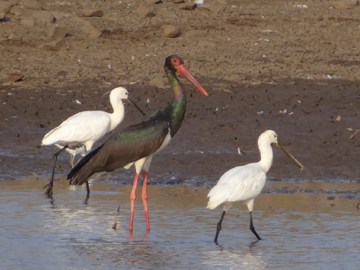
Black Stork
This year also the beautifulwinter visitors have arrived; few of them are local winter migratory like wagtail and ruddy shelduck. Ruddy shelduck do breed in Ladakh . Few others
have come from across Russia and Mongolia, for example, bar headedgeese do come from Mongolia. Researchstudy on migratory birds shows some amazing facts, bar headed geese (“raajhans“in Marathi) come from Mongolia. They were first sighted in 2009 by Mr.TarunBalpande
near to Nagpur. Bar headed geese had been collared in Mongoliato understand the migration of these species by the WildlifeConservation Society of Mongolia –by a team led by Martin Gilbert. Theycollared adult females with yellow collard “NU”. These yellow
collared bar headed geese adult femaleswere first sighted by the team of Mr.Tarun Balpande . They sighted this same adult female withcollar every year on the same place of first sighting. This is the fourth year when they sighted thisfemale at same place.
It almost covers 4800 km distance to reach this placefrom Mongolia . It shows that migratorybirds can visit same place for manyyears regularly.
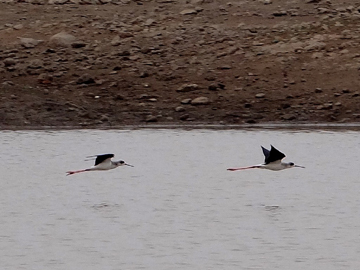
Black winged Stilts
Bird migration still remains a mystery,there are so many amazing facts related to migration of birds. Just before the migration, birds start deposition of fat in their body. When this fat reaches to certain level , birds begins to migrate, this phase
is called zugunrunhe in biological term. Ducks do fly in “v” shape formation to save energy. They use some flying zones as they know where to migrate, when to migrate, how to migrate. Few of them cross Himalayas as well. Global warming also affect the
numbers of migratory visitors. This year the birds reached Amravati a little late .
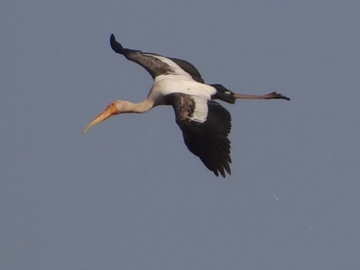
Painted Stork
Water bodies and surroundinghabitat is lifeline for this birds. Itis sad that they are being polluted due to many reasons. Not only water bodies but surrounding habitatgrassland,
marsh etc, are being affected. All migratory water birds are not dependent on water bodies for their food, few of themalso feed on grass seeds, insects etc.there are any number of reasons responsible for the destruction of theirnatural habitat viz. Fishing,
idol immersion during durga puja and ganeshpujan, illegal grazing on grassland nearer to riverine areas are some ofthem. Also Poisonous traps used for fishing and hunting.
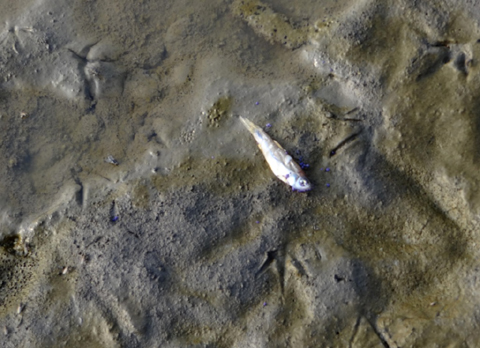
Poison crystals and a dead fish
We just sighted poisonous trap at a lake near to Amravati, we saw some fish covered with the poisonous crystals; we collected all the dead fish we could find, but unknowingly few
of them were left and one great egret died due to eating poisoned fish. We again saw net bird traps near to same lake after few days. There is need to protect certain places by forest department. Disturbance by the so called nature lover, tourist who often
visit those places for entertainment and throw garbage and waste in to water bodies, also needs to be mentioned here.
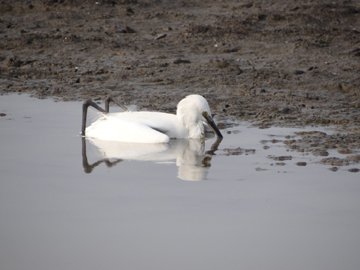
Dead egret
Due to loss of habitat, pink headed duck become extinct. ThePink-headed Duck (Rhodonessacaryophyllacea) that was once foundi n parts of the Gangetic plains of India,
Bangladesh and in the riverine swamps of Myanmar is feared to have gone extinct since the 1950s. Numerous searches have failed to provide any proof of continued existence. It has been suggested that it may have happened due to continuous destruction of
habitat. It also suggests the need for conservation of water birds species.
The Migration of birds to a certain place signifies the health of the habitat and it improves the richness i biodiversity too. For the c onservation of biodiversity of this area we
need to pay attention to the conservation of these water bodies. After that we have very common quote in Hindi“ atithi devo bhav “ which means “try to give comfort to guests”-please include your avian guests too in the term. We wish these beautiful avian
friends do visit us every year and make that habitat more graceful with their presence.
(Text and photographs by Prajakta Hushangabadkar)
|
Poem
Behrooz KY Avari
Who am I you ask?
I am the one who is put to task
To fill the pockets of the greedy
While the vast majority is left needy.
There is a plunder of my skin, my crust,
A race there is to exploit and thrust;
To thrust out what I hold in my bowels sodear
Without any thought for the future, no fear.
My breath is heavy, shallow and dark.
My nerves have been stripped along with theroots and bark.
For what? To gain more land, more paper,
Why this unthoughtful, demeaning caper?
Of the water of life I hold so holy
You keep abusing and turn its quality lowly.
Do you know you have snatched my glory, mycrown.
With the heat of conceit my glaciers aremelting down.
Other species that live on me maintain thebalance, they serve you
But treat them like chattel and deem themunintelligent you do.
With intelligence comes responsibility whenwill you learn,
The animals are crying out their goodconfidence do earn.
The warmth that surrounds me is not what Iwant,
Changing climates I do not want to flaunt.
I wonder how you live breathing in thispollution
And yet are successful in increasing yourpopulation.
How do I feel have you ever thought?
The advice of your Mother Earth have yousought?
Everything interconnects in the web of life,
Turn back it needs just a little strife.
© Behrooz KY Avari (2011)
|
Story Of The Month
Debashish Ray
It was a sunny Sunday morning one day in November ’82. I had pulled up a comfortable chair at one end of the large verandah in front of my home in Jamalpur. Across the old boiler-tube fence was a road lined with large
teak trees. The trees partly screened the golf course beyond,where on their weekly ‘off’ a few men were playing golf. They were dressed in the fashion of the time, in shorts that reached half way down their thighs,colored tops and light peaked caps.
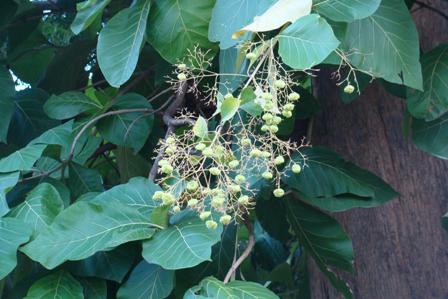
The Teak or "Sagwan"
Teenagers lugging heavy bags carrying the golfers’ assortment of clubs accompanied the men. And off course, there were the barefoot urchins in patched shorts, watching every move in this adult version of ‘gulli danda’.
Occasionally they helped out, their keen eyes locating balls lost in the knee-high fetid cassia shrubs that had overrun one end of the course. At the other end of the half kilometer, wide course was a mango tope,which provided suitable obstacles for flying
golf balls.

The Foetid Cassia or "Chakunda"
Further beyond the golf course was a large man made lake covered with lilies and lotus pads and some water chestnuts. It was an anglers and birdwatchers’ paradise with water birds and fishes a plenty. It was no surprise
that, I was often looking up from the book that I had sat to read.
I may have finished some fifty pages when I looked up to see one of the urchins running full tilt after a large brown bird that appeared to be hurt. It was thrashing along on the ground between the cassias out of reach
of the pursuing kid. My reaction was to mutter, “D---those s- -must have hit the bird with a ball or club”. Then after about some thirty metres the bird suddenly took off. Its flight showed no injury and then flashed a belated recognition-it was a Lesser Whistling
Teal.
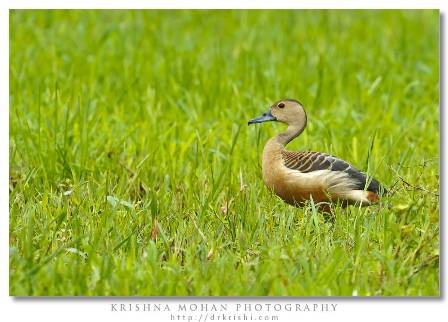
The Lesser Whistling Teal or Tree Duck, Dendrocygna javanica, "seelhi or Seelahi"
It took a few seconds to dawn that there was probably no injury. This was the ‘broken wing display’ that many ground nesting birds do when a predator gets close to their young. With the conflicting desire of protecting
their chicks and saving themselves from the predator, these birds go into a displacement activity, which suggests injury. Predators follow the apparently injured bird,as the urchin had done, thus lured away from an easy meal of helpless babies.
Pajamas and slippers not withstanding, I hotfooted across the road on to the golf course. Near the old golf pavilion with red brick wall and sloping roof, I found a huddle of men and boys. It appeared that the teal had
been leading her brood of ten ducklings across the field towards the lake when the urchins spotted them. One boy who had scooted home had already snatched two ducklings from the brood. The other eight were scurrying in a file following the lead duckling, piping
all the while in distress.
The mother bird meanwhile was flying in circles over head calling Sweety! Sweety! The ducklings were dark grey in color with white spots.Their beaks and feet were a leaden, a dark bluish grey. They had sharp black nails
on their webbed toes, which as I was soon to find out, were good for climbing.
I borrowed an ‘air bag’ from one of the golfers, and with the help of an urchin put the remaining ducklings in to it. The ducklings promptly started climbing up the rough lining inside and out of the bag. Keeping them
in was quite a job as at any time two would have popped their heads over the top and would need to be pushed back.
Bag in arms and boy in tow I walked towards the lake on the far side. The ducklings kept up their piping and attempts to climb out of the bag. The mother duck was flying higher often out of sight beyond the trees.
As I walked towards the lake, I remembered seeing a pair of Lesser Whistling Teals several times, flying tree height over the golf course a month earlier. Had wondered then as to what they were doing there. Perhaps these
tree ducks had built a nest in some hollow in the mango tope or the large peepul near the golf pavilion.
The waterside of the lake was open with only a few scattered tad palms around. Released the ducklings some distance from the water and moved away to give the mother a chance. Meanwhile the two of us moved further away
holding stones to pelt any crow that showed interest. After what seemed an eternity the mother who had been calling overhead, landed near her brood. The ducklings latched onto her immediately. With head held low, eyeing us with suspicion the duck led her brood
into the water beyond.
-----------------------()---------------------------

Key to the scientific names of plants and bird in ‘The Broken Wing’ in order of occurrence in text.
Teak, Tectona grandis.Young seedlings have quadrangular stems and very large elastic leaves.
Foetid Cassia or Sickle Pod, Cassia tora. Known in Sanskrit as ‘Dadamari’ for the fungicidal and bactericidal properties of the leaves and seeds.
Mango, Mangiferaindica. The wild variety grows up to 45m tall, with a domed crown. Their leaves and fruits are smaller than those of cultivated varieties.
Common Water Lily, Nymphaeapubescens. All leaves floating on the water surface with sharply toothed leaf margin.
|
Wild rescue
-Input from Prateush Muraleedharan
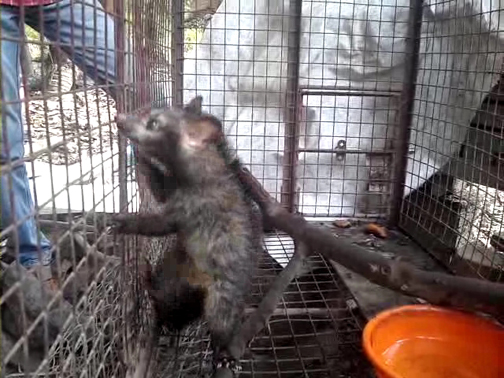
The above photo is that of a civet which was rescued from a house near Aluva, Kerala. He was under fed
and confined to a small cage. The owners were afraid of him and were not able to release him because
they owned a chicken farm and feared for the life of their chicks. When they contacted Prateush, he
immediately went to collect him and handed him over to Kodanadu forest range where he is being nursed
back to health.
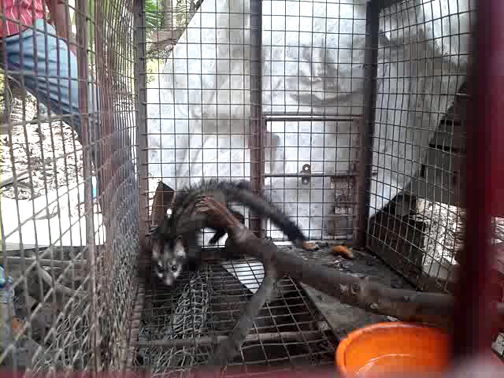
Pratheush k Muraleedharan (age 21) is a wild life enthusiastic and a wild life rescuer for past many
years. He has been engaged in snake rescuing and wild life rescuing for past 5 years. He rescues both
venomous and non venomous species from human populated area and release them to the forest with the
help of the forest range office located nearby.
He also rescues exotic illegal pets from various people’s houses and try to educate them about the
various aspects of wildlife trade and the importance of the sustenance of various wild life species
in his locality. He was an aeronautical engineer by profession with Mesco airlines, Mumbai but always
knew that his life rested with animals, so he resigned.
Now he is engaged in animal husbandry in his own property. Presently he owna an ornamental fish farm
and a small kennel. He has experience with almost all venomous and non venomous species of snakes,
along with various other animals like Asian palm civets and exotic birds.
See a youtube video showing the hapless civet in the cage at the following link
http://youtu.be/DUEF4Lhqb90
|
Wildlife Photolog
Ajay Jain
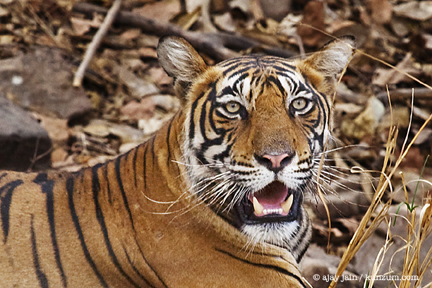
The baby tiger cub, a close-up
Would you ride in an open Gypsy in temperatures exceeding 50 degrees Celsius? With the sun threatening to burn everything in sight, and the desert sand piercing your skin like countless needles? You would, if you were on the trail of the tiger in the Ranthambhore
National Park in Rajasthan. One of the few forests in India where tigers still prowl, you can be almost assured of a sighting – but only if you venture out when summer is at its harshest. This is when water sources dry up, and animals come out in the open
to water holes. And the dry vegetation makes camouflaging difficult. The roll of dice can still go against you, or you may be lucky like me – with seven sightings over a single weekend.

T17 on the prowl after a failed hunt
The opening act turned out to be the best – and a rare one at that. I spotted a male tiger, named T2 by the creativity deficient authorities, sitting by a water hole and a recently hunted langoor monkey lying in state three feet away.
I was not more than ten feet away myself. T2 was waiting patiently, either for a guest or for the dinner bell to sound, when something in the water disturbed him. He slowly turned his head, looked for a few moments through the surface and then it was Pow-Wow
in a flash. A poor turtle had floated in, and was probably the starter (or was it dessert) that T2 was waiting for. For the next many seconds, all one could see was frantic splashing as the turtle put up a brave fight. Before long, it was all tranquil again.
The big cat had expectedly won, but it would be a while before he could carve the flesh out from under the hard shell. Witnessing a tiger in action live beats the most spectacular of hunts you would see on National Geographic.
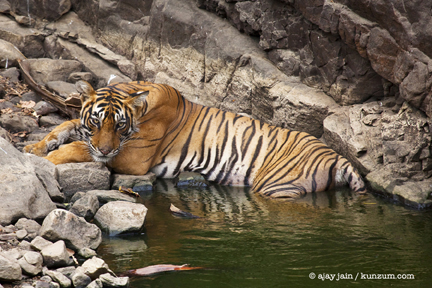
T2, waiting to eat the langoor he had hunted a few minutes before
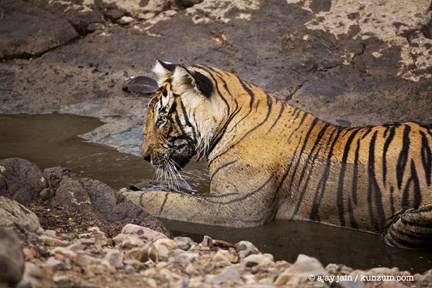
T2 trying to eat the soft underbelly of the turtle under its hard outer shell
It would be morally illegal to have a perfect trip, but I almost did. The following morning I encountered another male, T17 (these tigers will make someone pay for these disgraceful names), looking hungrily at a herd of deer around a small lake. He weighed
his options, made some calculations, and was off like a shot – a yellowed silhouette of a torpedo racing through tall grasses at his target. But it turned out to be a dud. The chap could have done with some heat sensing technology, like the Scuds, to home
into his prey. Before long, he wandered aimlessly and crossed in front of my Gypsy – a scrawny fellow looking malnourished. Needs to be a better hunter I guess. He also had what looked like a dog strap around his neck. T17 has a tendency to wander outside
the reserve area – the installed tracker helps pull him by the ears right back where he belongs. True to his reputation, he crossed the limits the same evening. I was driving around in my own car around the periphery of the forest when he ambled across on
the road. Still looking for food. He finally settled for a stinking carcass in a baoli (stepwell) – certainly not a meal fit for a royal species. But times can be hard for anyone.

The baby tiger cub lounging in a water pool
The most entertaining was a tiger cub – actually more like an overgrown baby. At three years, he looked much sturdier than the adult T17. And he still had to learn to hunt. I guess being fed by the mother does have its advantages. Still to be christened, let’s
call him Baby T (where is my creativity now), he was lounging in the shade for hours at another water hole, probably waiting for his mother and siblings. A bunch of langoors must have known his teeth and claws carry no firepower yet – and took it upon themselves
to tease him. Perched on a long branch right above his temporary abode, they danced and made noises at Baby T incessantly for hours. But our boy made sure he sent a message across – by looking back at them with snarling expressions as if to say, “It is just
a matter of time before you guys will be on my plate. So stop monkeying around.” Despite waiting forever, the rest of the family failed to make an appearance for our entertainment.
Ranthambhore: Travel Tips
• Booking for safaris can be made online at
http://www.rajasthanwildlife.in – always a good idea to do so in advance during peak seasons. There is an option of going in a canter bus (seating 20) or in a Gypsy (for 5); the latter is the better option.
• You can drive to Ranthambhore from Delhi – it is 400 kms (250 miles) and takes 6-7 hours. Many trains also go to Sawai Madhopur, the town adjoining the park.
• For best sightings, go from April – June. Tourist traffic will also be low, and hotels offer great discounts.
• Ranthambhore is full of properties for all budgets – starting with the pricey Oberoi Vanyavilas down to rooms costing no more than a few hundred Rupees a night. Food is best had at the places you are staying – unless you want to venture into town where the
options are not really much to write home about.
• The park is usually closed from July 1 – September 30.
|
Wildlife Photolog
Ranthambore Again!
-Ajay Jain
Having been to innumerable jungle safaris, I have learnt one thing: for a truly enjoyable experience, think beyond the main attractions, in this case the tigers. And a wealth of beauty awaits. Take the common langoor monkeys – you cannot help but wonder how
they can be so close to humans in their mannerisms.

Or even the deer we take for granted: all species have large, beautiful eyes for one. And just when you think the Spotted Deer are a gentle lot, they will start fighting amongst themselves. Over what? A lady deer? No one knows.
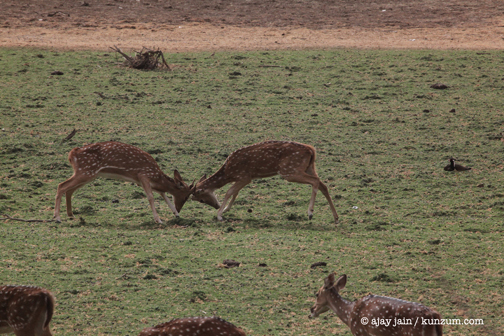
Not to be missed is the Ranthambhore fort, built in 944 A.D. located at the entrance to the reserve. In winters it can be a challenge going all the way up the fort built 700 feet above ground level; if you can do it in summer, you deserve a free pass to a masseur
and a Jacuzzi for a year. That is, if you survive the heat and fatigue going up and down. Surprisingly, many a brave soul do and live to tell the tales. For locals, a major attraction is the temple inside; wannabe brides and grooms make it a point to seek
blessings here before tying the knot.
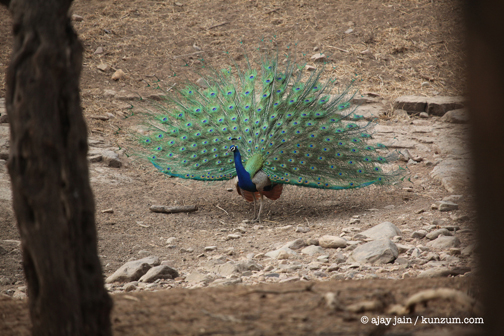
When not in the forest, it’s enjoyable walking in the fields and woods along the road from Sawai Madhopur to the park’s gates. In the right season, you can hope to spot many birds, animals going astray, some shops selling local handicrafts, paintings and more.
If trains excite you, go to the Sawai Madhopur station and hang around – it is a major junction for trains including the Rajdhani to Mumbai.
 pair.jpg)
Of course, you can go to Ranthambhore anytime except when the park is closed from June to September. The cooler it gets, the bigger the crowds – but lesser the sightings. When are you packing for the safari?
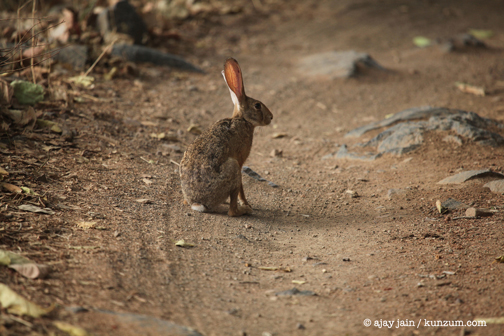
Ranthambhore: Travel Tips
• Booking for safaris can be made online at http://www.rajasthanwildlife.in – always a good idea to do so in advance during peak seasons. There is an option of going in a canter bus (seating 20) or in a Gypsy (for 5); the latter is the better option.
• You can drive to Ranthambhore from Delhi – it is 400 kms (250 miles) and takes 6-7 hours. Many trains also go to Sawai Madhopur, the town adjoining the park.
• For best sightings, go from April – June. Tourist traffic will also be low, and hotels offer great discounts.
• Ranthambhore is full of properties for all budgets – starting with the pricey Oberoi Vanyavilas down to rooms costing no more than a few hundred Rupees a night. Food is best had at the places you are staying – unless you want to venture into town where the
options are not really much to write home about.
• The park is usually closed from July 1 – September 30.
|